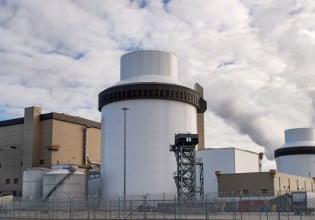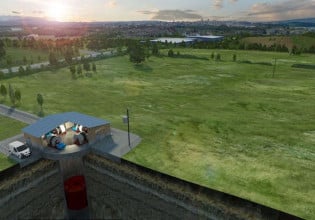Configurable Power Supply Adds Liquid Cooling Option
Advanced Energy’s iHP Liquid configurable power supply uses liquid cooling to deliver up to 20 kW of power in a 4U rack form factor for applications where fan-based air cooling is not practicable.
Advanced Energy has developed iHP Liquid, a liquid-cooled variant of the air-cooled iHP series configurable power supply that can deliver up to 20 kW of DC output power from a 4U rack enclosure.
Advanced Energy’s iHP Liquid has eight output modules configured in a single enclosure. Image used courtesy of Advanced Energy
The iHP Liquid series consists of an AC front-end that can drive up to eight different output modules in a single enclosure with nominal voltages ranging from 12 V to 250 V. The supply is highly configurable, allowing output modules to be operated in series, parallel, or independently for system output voltages as high as 1000 V and output current up to 1600 A.
The AC front-end accommodates single- and three-phase line power (480 VAC nominal) and uses active power factor correction (PFC) to maximize the use of power from the grid (power factor of 0.98 at full load) and mitigate input current harmonics (THD).
iHP Liquid 20 kW AC-DC configurable power supply. Image used courtesy of Advanced Energy
The liquid cooling option is ideal for applications where fan-based cooling is not preferred due to the presence of airborne dirt, moisture, or other contaminants.
The flexibility and configurability of the iHP series make it well-suited to industrial, lighting, horticulture, medical, and semiconductor applications.
Configurable Power Supplies
A configurable power supply is a power supply that can be constructed with one or more output power modules connected to a common AC front-end that converts AC line power to DC.
The iHP series is a family of configurable power supplies with an AC front-end that accommodates single- or three-phase (4-wire Wye or Delta) line input power (480 VAC, 50/60 Hz nominal). Along with the AC front-end, the main enclosure incorporates up to eight output modules that convert DC power from the AC front-end to nominal, regulated DC output voltages ranging from 10 to 250 VDC.
iHP series DC output module options. Image used courtesy of Advanced Energy
With fan-based air cooling, the iHP series can deliver up to 24 kW of output power in a single 3U enclosure, with each of the up to eight output modules delivering 3 kW. With liquid cooling, the iHP Liquid supports an aggregate output module power of 20 kW in a single 4U enclosure. Liquid cooling eliminates the need for fan-based air cooling in environments where air quality might not be ideal due to airborne dirt, moisture, or other contaminants.
The output of the iHP series modules is highly adjustable and can be operated in constant current or constant voltage mode through a simple analog interface (0 to 10 V; 0 to 5 V) or a digital interface that is accessed through a separate PowerPro connect module.
Individual output module. Image used courtesy of Advanced Energy
Along with independent operation, individual modules within the enclosure can be operated in series to generate output voltages as high as 1000 V or in parallel for cumulative output currents up to 1600 A on a single rail.
Active Power Factor Correction (PFC)
The AC front-end of the iHP series employs active power factor correction at the input rectification stage to achieve a low harmonic distortion (THD) and a power factor that exceeds 0.98 at full load.
With active PFC, a switching boost regulator or other inductor-based topology is placed between the input diode bridge and DC-DC conversion stage to help manage input voltage and current phase delays (power factor correction) and mitigate distortion from input current harmonics.
Active power factor correction circuit. Image used courtesy of TI
The inductive reactance of the boost circuit works with the reactance of the input storage capacitor to help bring input current and voltage in phase and toward unity PFC. Unity PFC, or a PFC of 1, is when input current and voltage are fully in phase, and the power delivered by the grid matches the power consumed by the load, so no energy is wasted due to phase mismatches.
Without active PFC, the hard cycling of the diode bridge into the input capacitor can generate large input current harmonics (distortion) that may prevent the supply from meeting certain regulatory standards.
Horticulture Applications – Precision Lighting
For some applications, like horticulture, lighting is not just lighting. In controlled-environment agriculture, the amount of light energy to crops needs to be precisely controlled to optimize yields.
Indoor horticulture typically uses LED lighting. As opposed to an individual driver for each LED light, a centralized supply architecture, like the iHP series, can reduce lighting system costs with fewer active components and less wiring while also improving performance with higher power factors, centralized monitoring, and control.
Using a centralized rack supply for two grow rooms. Image used courtesy of Advanced Energy
A centralized approach allows for a single rack supply to power lighting in two separate grow rooms, with each room’s lighting system powered for 12 hours a day. This allows for 100 percent utilization of the supply capacity for better cost efficiency.












